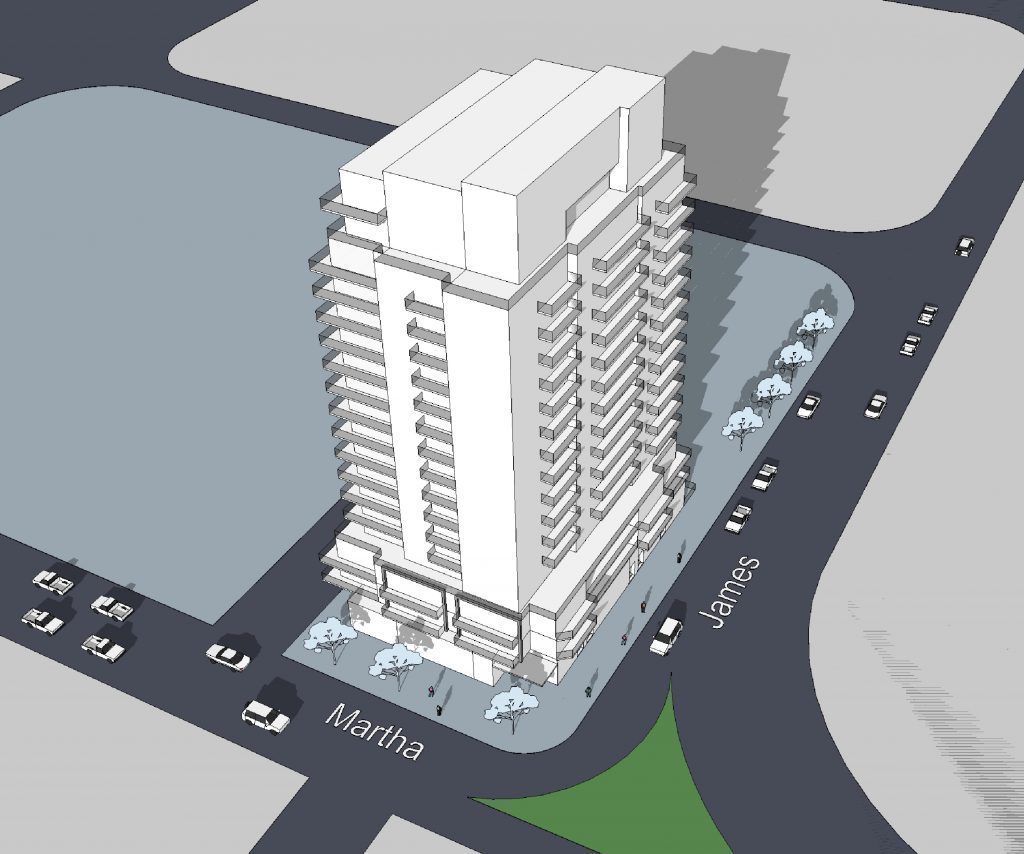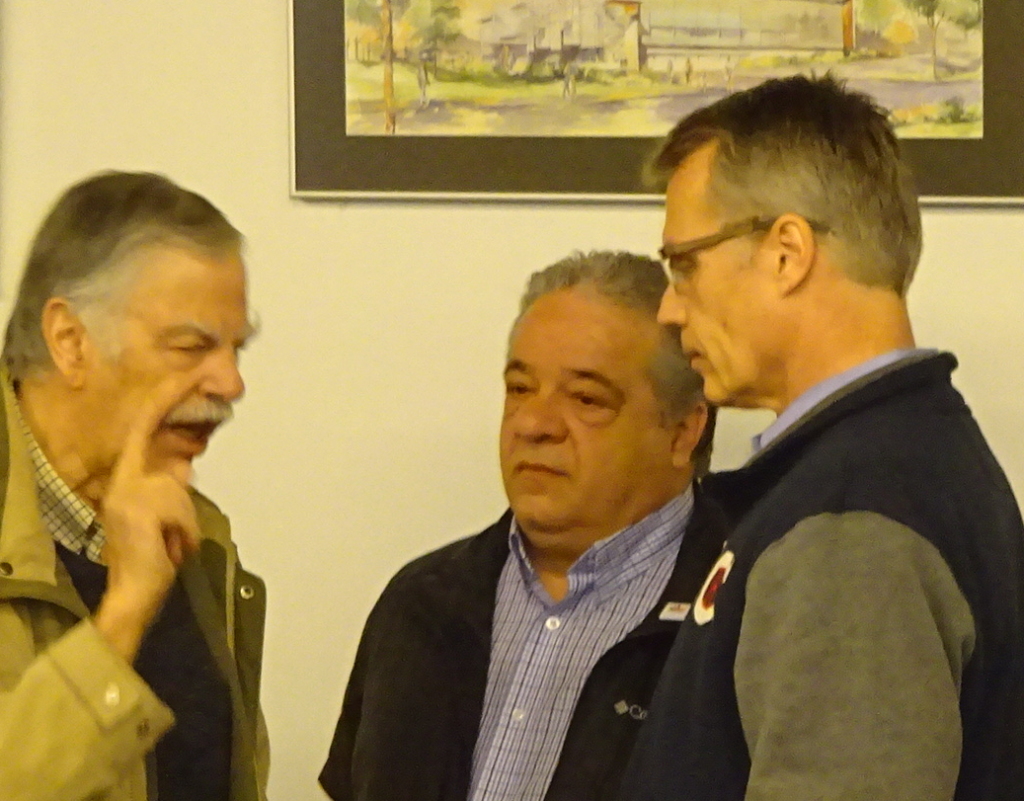 By Staff
By Staff
April 5th, 2018
BURLINGTON, ON
The announcement of an 18 storey structure at the intersection of James and Martha is one more addition to the very significant changes that are taking place in the city.
At a recent community meeting – a number of questions were asked – the answers were insightful – even if they are not what people want to hear.

Burlington’s former Director of Planning Bruce Krushelnicki
Burlington’s former Director of Planning Bruce Krushelnicki was on Cogeco’s TV with moderator Mark Carr who asked Krushelnicki just how and why all this intensification is taking place. Krushelnicki, who was always very good at explaining just what planning issues are all about, gave interesting answers. His comments are short – 4 minutes; well worth listening to.
Watch the video CLICK HERE
The following comes to you via information originally published by ward 2 Councillor Marianne Meed Ward
1. How is the Ontario Municipal Board (OMB), different from the new Local Planning Appeal Tribunal (LPAT)?
A key difference is that the OMB bases decisions on what is good planning whereas the LPAT is more restrictive—they will ask if the development is conforming to provincial and regional plans.

Proposal is for an 18 storey building with 153 units.
2. What is happening to the creek?
Realignment of the channel is proposed. Some vegetation will be cut out to create better flow condition. A flood analysis has been done, and flood elevation will be reduced.
3. Will pumping be required for the underground parking?
There will be pumping required.
4. Are you putting cement in creek?
A retaining wall will be right at the creek.
5. What is the design factor for the flood plain?
The City’s Capital Works department will be looking at both regional and 100-year policies. Site engineering staff will be looking at technical studies to ensure there are no adverse impacts to the creek.

An unhappy transit customer talking to the Mayor and Director of Transportation at a Bfast Forum.
6. Many residents expressed concern that traffic will be worse in the local neighbourhood.
City staff stated that they will ensure that traffic is within acceptable levels by conducting traffic forecasts and redistributing traffic. Staff will look at existing traffic patterns.
The forthcoming Transportation Plan has an emphasis on moving people, not cars… Staff are not expecting that every trip is going to be made by car and believe that people travel at different times during the day.
7. What magnitude of change are we going to see in traffic volumes? Will neighbouring developments be considered in forecast?
Anticipating 40 trips in a peak hour. Staff will be layering every development within proximity.
8. Why are we amending official plan, without transportation plan?
9. Multiple residents are concerned that this development is the beginning of many more like it, and we do not have the infrastructure and roads to support the volume.
Staff will not be widening roads, instead they are looking into transit, and moving people in a sustainable way. Staff are in early stages of reviewing transportation and traffic.
10. Who is going to pay for the sewage and transportation upgrades that will be required due to the increased usage that the development will bring?
Halton Region will determine if there is capacity for our sewage system. The developer pays upfront, and in long-term residents pay through taxes.
11. Would Mattamy have been interested in the site if they could have only gone to 11-storeys?
No, due to the cost to develop site.
12. By the time we get to the site plan phase, the applicant will have already been granted high density.
13. What allowances have you made for visitor parking?
31 parking spaces will be provided on first level.
14. We all chose to live here because it’s not downtown Toronto (congestion). How will you ensure pedestrian safety?
Applicant hasn’t gotten to that stage yet.
15. What is the estimated build time? What street will you be using for staging?
2 years for construction…. doesn’t have answers for staging area yet.
16. Is there going to be a drop off area at the entrance of the building? Resident recommends roundabout at corner of Martha and James.
There will potentially be 2 or 3 spaces at the front of the building for drop-offs.
17. Can City ask applicant to also put together an 11-storey application to compare to the current application in real time?
Would be expensive for developer.
18. Can the developer explain how the development fits with the character of the neighbourhood of 1 to 3-storey buildings?
Downtown is a mobility hub and what you see today is not what you’re going to see in the future. The character is shifting and downtown is going to change.
19. What is price point of units? Will there be affordable housing?
Mattamy doesn’t have answers at this point…application is in early stages.
There were a lot of ‘pig in a poke’ answers given at that meeting. Exactly what does: “Staff are looking into transit, and moving people in a sustainable way.”, mean? You may not want to know.
When you hear what Krushelnicki had to say on Cogeco TY (link to that conversation is above) you will begin to understand why Burlington is going through the changes ahead of the city.





















There are a lot of gaps in the responses to the questions. Parking is a big one. Does anyone really believe that moving vans are going to park undeground when people move in and out? What will an ambulance do if the three ground level spaces are already occupied? Where will construction equipment be during the year it takes to build?
And traffic – with the massive ADI building at the other end of the block, is 40 movements per hour acceptable on top of another 60? 80? Who knows?
Also, the explanation of OMB vs LPAT seems wrong. OMB has always focussed on whether the correct planning process has been followed for the specific case at hand (and ONLY that case) regardless of whether the result is reasonable – any other factors like availability of transit or schools or parks in the area are irrelevant. I Thought LPAT was to be allowed a more holistic scope.
I expected the above succinct yet obtuse answers from any bureaucrat and that is what Mr. Bruce Krushelnicki is.
I am amazed he has not decided to run in one of the many open Liberal rides being abandoned in droves at the current moment.
Re: “Staff are not expecting that every trip is going to be made by car and believe that people travel at different times during the day.”
That’s a pretty sloppy assumption. Why does Burlington even have a Planning Department, if that kind of drivel is the best that they produce?
Oh my, the OP seems to be set in stone, the downtown area has been chosen the intensification zone because the anchor mobility hub will move the masses without a problem, BUT, BUT, when putting the puzzle together to make this OP work, we keep hearing “STAFF PRESENTLY ARE ONLY IN THE EARLY STAGES OF REVIEWING TRANSPORTATION AND TRAFFIC”. One needs no brains to understand that the OP should not go forward until such transportation and traffic guidelines have been met!!!!!!!!!!!!!!!!!! One leg cannot move in conjunction without the other, therefore, this Plan should not have the designation Official”! We the citizens all know that, “the complete package” has not been delivered, therefore in the records will be, to little too late, ‘BAD DECISION MAKING”! Did a drive-by Burlock with “all the commercial and industrial developments going on”, and I have not seen plans for any Harvester residential hi-rise developments to tie into the future employment in those areas?? Keeping work related areas close to home is what you are leading us to believe is your platform, with present plans only producing gridlock downtown, going nowhere fast, for employment elsewhere. ????? SERIOUS thoughts are needed!!!!!!
I attended the meeting and it left me and other residents of downtown further disillusioned with the direction this city has taken. The developer and city representatives could not answer specific questions on the impact of the surrounding neighbourhood in regards to safety, shadow impact and traffic concerns. They answered with generic model forecast (weather models always are correct- ha ha )and traffic will magically shift to other times of the day. Like all meetings the citizens continue to get frustrated and disappointed. The City stamps the approval and we all go home shaking our heads. The Engaged Citizens of Burlington signs can be seen on almost every street downtown now. I guess the planners from Toronto, staff from Hamilton and St. Catharines do not see them. I am not sure how the Developer representative Glen Welling also a downtown resident can stand in front of a crowd of peers and state this building fits the character of the neighbourhood. It is no longer the time to be civil as they are not treating us with the respect we deserve. I bought my home as a place to live and enjoy the quality of life downtown, now it will have a tower looming over it. Their presentation was less informing than a Grade 2 science project. Actually, they would present facts and realities.
Cogeco TV’s Mark Carr missed a golden opportunity to ask Mr. Bruce Krushelnicki what happens when our city is already meeting the provincially mandated 200 jobs/people per hectare. The in-situ reality is there is no limit, the sky is the only limit.
You’ll notice that Mr. Krushelnicki says a municipality can add mobility hubs, but fails to answer whether it can remove a mobility hub. Only says “that’s trickier”. Doesn’t say it can’t be done.
I’m an optimist and remain so until proven wrong. Burlington’s downtown is unsuitable to the onslaught of 20 plus storey high rises that create the high degree of intensification demanded by the Urban Growth Centre and Anchor Mobility Hub designations. Our bus kiosk has no hope of becoming the rapid transit link to the GO Station that it must be if it truly qualifies as an Anchor Mobility Hub.
Council knows this, as does the Planning Department. I have asked twice and will ask again at the next Planning and Development Committee meeting. Approach the Province and ask that these designations be removed from the downtown. Oakville successfully did so in 2005 and retains full control of its downtown density, building height and redevelopment planning.
Our city has lost control of its redevelopment planning in the downtown. There are no height limits in the Province’s plan for the growth centres. Developers know this and city planners struggle to limit height with little hope or evidence to support their arguments.
The change from the OMB to the LPAT will still not help a growth centre regain control of development. Neither will a new Official Plan. It’s only a band-aid that tries to lessen the bleeding. We need to remove the cut. No one has said it can’t be done. Yet no one in authority has even tried. Yet. I remain an optimist.
Re: the video. Three things become apparent:
1) In Kathleen Wynne’s Ontario there is no such thing as local planning autonomy or discretion. Everything must conform to the tenets of her government’s central planning model.
2) This is essentially a Toronto-centric planning model. What the Ontario government and Metrolinx want is all important. To hell with anything else.
3) Uniformity is all important. There is no interest in or consideration of local neighbourhoods, character, distinctiveness, etc. The focus is upon building one amorphous mass of dull, lifeless, boring, mundane and ugly condos to warehouse thousands of people. Welcome to Pyongyang West!!
Just another in a growing litany of reasons why this provincial Liberal government needs to be dumped in June. it is bad enough that this reckless and fiscally irresponsible government squanders money they don’t have to try and buy votes. Now they want to dominate and control every aspect of local and regional government as well.
As for the article, the lack of definitive answers to questions 6, 7, 8, 9 and 14 is not only alarming, it is frankly appalling. Question 17, which is the same question I have heard Greg Woodruff asks innumerable times on various posts, is not only evasive it is core to this issue. If developers insist on spouting this mantra then please provide documented, verifiable evidence to support the claim that an 11-storey building is not financially viable…or is it a case that developers will only be able to make modest profits instead of egregious ones? I suspect when you come right down to it this is what it is all about: $$$$$
Stephen,
Speaking of $$$$$, your point is right on, as that is what it is really about, and has other dimensions.
I had an email conversation with Penny late in March, and we were talking about Section 37 Benefits, which is timely again regarding the 421 Brant St project report on these coming to Council next week.
Penny said; “The City can call it Section 37 or Community Benefits, I always think of it is as bribery. The developers bribe the City for height with ridiculous benefits.”
I replied, I know what you mean, but it’s part of the Planning Act, so what do people do?
What I want to know is how the “Benefits” are calculated, with transparency.
Is it a bribe in concept ? – it’s cashing in on the City ability to create money with the OP and Zoning permissions.
Don’t ever think only central banks can create money out of nothing but air (height and density rights written on paper).
This is a powerful wealth creation tool that most people don’t think about really until times like now when the overall “air parcel” bits and pieces, sprinkled all over the place, that is driving the money value, gets too big not to notice.
Just imagine – creating 26 floors of nominal residential space, by converting zero floors of empty space (one can imagine converting 2 or 4 floors) of commercial/retail space with half the unit value, is a mighty injection of wealth created out of practically or comparatively nothing.
The per unit land values, and associated rents, of course inflate in some multiple of proportion of the expected gross return of the build.
Maybe a reader out there, with expertise in this area, can give us some accurate quantity insight into this. maybe the city planners can give us a clue, or someone in charge of keeping track of these values.
And of course, you have to add in all the negative costs and crap and inflation and lost existing business income that goes along with this set of tear-downs, that gets dumped on residents and businessmen, for them to bear.
So, the city ought to cash in on what it creates, since they control it and it is the city. It needs a very close look.
If Section 37 benefits are to be calculated, then these are the land value gains, and residents costs, that should determine what these are.
And this is another reason why the city must not give away all the heights to developers “by right”, where there are no Section 37 benefits allowed.
Since writing on this, we have here learned more of the Province’s role, and apparent overbearing control of this development process, and what will be allowed, or better said, what must be allowed.
That a single OMB Chair determined that 26 stories must be created out of an empty lot, is a powerful indictment of the provincial control of development. And our Council just seems to sit around and go along with it.
People writing here, and Councilor Meed Ward, have pointed to something concrete that they can do, to wrest at least some control back to us, but I see no movement in this direction.
If the province is really in control, (as it appears) regardless of the City OP, Zoning, and resident and city wishes, then we do need to look to the province and call them to account.
Apparently, they are the ones running the money machine.